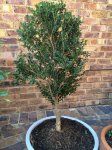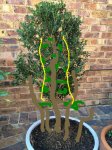Dorian Fourie
Chumono
I have a boxwood that my wife used as mini Christmas tree 2 years ago. Since then it has been planted in a pot outside. I needed to use the pot for something else so I transplanted it into a plastic container that I had lying around.
Now I believe that they make nice bonsai.
So suggestions on where to next. Right now we are heading into Autumn here in South Africa so I think it would be best to wait for Spring (Sept).

The height from the base to the first branches is 20cm (7.9 inches) and the trunk is 3.5cm (1.4 inches) wide at its thickest part.



I believe that this should be the front of the tree due to the "fold" in the trunk as it will add some nice character to the tree.
Because of the upright trunk I think the only styles that will work on this is either Formal upright or Broom style.
But where too next? Can one do a trunk chop and let it grow out?
All thoughts and suggestions welcome.
Now I believe that they make nice bonsai.
So suggestions on where to next. Right now we are heading into Autumn here in South Africa so I think it would be best to wait for Spring (Sept).

The height from the base to the first branches is 20cm (7.9 inches) and the trunk is 3.5cm (1.4 inches) wide at its thickest part.



I believe that this should be the front of the tree due to the "fold" in the trunk as it will add some nice character to the tree.
Because of the upright trunk I think the only styles that will work on this is either Formal upright or Broom style.
But where too next? Can one do a trunk chop and let it grow out?
All thoughts and suggestions welcome.









